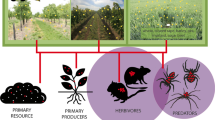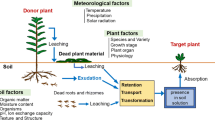Abstract
Inducible terpenes and lipoxygenase pathway products, e.g., green-leaf volatiles (GLVs), are emitted by plants in response to herbivory. They are used by carnivorous arthropods to locate prey. These compounds are highly reactive with atmospheric pollutants. We hypothesized that elevated ozone (O3) may affect chemical communication between plants and natural enemies of herbivores by degrading signal compounds. In this study, we have used two tritrophic systems (Brassica oleracea–Plutella xylostella–Cotesia plutellae and Phaseolus lunatus–Tetranychus urticae–Phytoseiulus persimilis) to show that exposure of plants to moderately enhanced atmospheric O3 levels (60 and 120 nl l−1) results in complete degradation of most herbivore-induced terpenes and GLVs, which is congruent with our hypothesis. However, orientation behavior of natural enemies was not disrupted by O3 exposure in either tritrophic system. Other herbivore-induced volatiles, such as benzyl cyanide, a nitrile in cabbage, and methyl salicylate in lima bean, were not significantly reduced in reactions with O3. We suggest that more atmospherically stable herbivore-induced volatile compounds can provide important long-distance plant-carnivore signals and may be used by natural enemies of herbivores to orientate in O3-polluted environments.



Similar content being viewed by others
References
Agelopoulos, N. G. and Keller, M. A. 1994. Plant–natural enemy association in tritrophic system, Cotesia rubecula–Pieris rapae–Brassicaceae (Cruciferae). III: Collection and identification of plant and frass volatiles. J. Chem. Ecol. 20:1955–1967.
Agrell, J., Kopper, B., Mc Donald, E. P., and Lindroth, R. L. 2005. CO2 and O3 effects on host plant preferences of the forest tent caterpillar (Malacosoma disstria). Glob. Change Biol. 11:588–599.
Atkinson, R. and Arey, J. 2003. Gas-phase tropospheric chemistry of biogenic volatile organic compounds: a review. Atmos. Environ. 37:S197–S219.
Baldwin, I. T., Halitschke, R., Paschold, A., Von Dahl, C. C., and Preston, C. A. 2006. Volatile signaling in plant–plant interactions: “Talking trees” in the genomics era. Science 311:812–815.
Bruce, T. J. A., Wadhams, L. J., and Woodcock, C. M. 2005. Insect host location: a volatile situation. Trends Plant Sci. 10:269–274.
Calogirou, A., Larsen, B. R., Brussol, C., Duane, M., and Kotzias, D. 1996. Decomposition of terpenes by ozone during sampling on Tenax. Anal. Chem. 68:1499–1506.
Calogirou, A., Larsen, B. R., and Kotzias, D. 1999. Gas-phase terpene oxidation products: a review. Atmos. Environ. 33:1423–1439.
Cameron, P. J. and Walker, G. P. 1997. Host specificity of Cotesia rubecula and Cotesia plutellae, parasitoids of white butterfly and diamondback moth. Proc. NZ Plant Prot Conf. 50:236–241.
Canosa-Mas, C. E., Duffy, J. M., King, M. D., Thompson, K. C., and Wayne, R. P. 2002. The atmospheric chemistry of methyl salicylate—reactions with atomic chlorine and with ozone. Atmos. Environ. 36:2201–2205.
Coleman, J. S. and Jones, C. G. 1988. Plant stress and insect performance: cottonwood, ozone and a leaf beetle. Oecologia 76:57–61.
De Boer, J. G. and Dicke, M. 2005. Information use by the predatory mite Phytoseiulus persimilis (Acari: Phytoseiidae), a specialised natural enemy of herbivorous spider mites. Appl. Entomol. Zool. 40:1–12.
De Boer, J. G., Posthumus, M. A., and Dicke, M. 2004. Identification of volatiles that are used in discrimination between plants infested with prey or nonprey herbivores by a predatory mite. J. Chem. Ecol. 30:2215–2230.
Dicke, M. 1999. Evolution of induced indirect defence of plants, pp. 62–88, in R. Tollrian and C. D. Harvell (eds.). The Ecology and Evolution of Inducible Defenses. Princeton University Press, Princeton, New Jersey.
Dicke, M. 2000. Chemical ecology of host–plant selection by herbivorous arthropods: a multitrophic perspective. Biochem. Syst. Ecol. 28:601–617.
Dicke, M., Takabayashi, J., Posthumus, M. A., Schütte, C., and Krips, O. E. 1998. Plant–phytoseiid interactions mediated by herbivore-induced plant volatiles: variation in production of cues and in responses of predatory mites. Exp. Appl. Acarol. 22:311–333.
Gate, I. M., Mcneill, S., and Ashmore, M. R. 1995. Effects of air pollution on the searching behavior of an insect parasitoid. Water Air Soil Pollut. 85:1425–1430.
Holopainen, J. K. 2004. Multiple functions of inducible plant volatiles. Trends Plant Sci. 9:529–533.
Holopainen, J. K., Kainulainen, P., and Oksanen, J. 1997. Growth and reproduction of aphids and levels of free amino acids in Scots pine and Norway spruce in an open-air fumigation with ozone. Glob. Change Biol. 3:139–147.
Holzinger, R., Lee, A., Paw, U. K. T., and Goldstein, A. H. 2005. Observations of oxidation products above a forest imply biogenic emissions of very reactive compounds. Atmos. Chem. Phys. 5:67–75.
Ibrahim, M. A., Nissinen, A., and Holopainen, J. K. 2005. The response of Plutella xylostella and its parasitoid Cotesia plutellae to volatile compounds. J. Chem. Ecol. 31:1969–1984.
IPCC. 2001. Climate Change 2001: The Scientific Basis. Report of Working Group I of the Intergovernmental Panel on Climate Change, IPCC, Secretariat, Geneva, 2001). http://www.ipcc.ch/pub/spm22-01.pdf.
Jøndrup, P. M., Barnes, J. D., and Port, G. R. 2002. The effect of ozone fumigation and different Brassica rapa lines on the feeding behavior of Pieris brassicae larvae. Entomol. Exp. Appl. 104:143–151.
Joutsensaari, J., Loivamäki, M., Vuorinen, T., Miettinen, P., Nerg, A.-M., Holopainen, J. K., and Laaksonen, A. 2005. Nanoparticle formation by ozonloysis of inducible plant volatiles. Atmos. Chem. Phys. 5:1489–1495.
Kappers, I. F., Aharoni, A., Van Herpen, T. W. J. M., Luckerhoff, L. L. P., Dicke, M, and Bouwmeester, H. J. 2005. Genetic engineering of terpenoid metabolism attracts bodyguards to Arabidopsis. Science 309:2070–2072.
Kesselmeier, J. and Staudt, M. 1999. Biogenic volatile organic compounds (VOC): an overview on emission, physiology and ecology. J. Atmos. Chem. 33:23–88.
Kopper, B. J. and Lindroth, R. L. 2003. Effects of elevated carbon dioxide and ozone on the phytochemistry of aspen and performance of an herbivore. Oecologia 134:95–103.
Mattiacci, L., Dicke, M., and Posthumus, M. A. 1994. Induction of parasitoid attracting synomone in Brussels sprouts plants by feeding of Pieris brassicae larvae: role of mechanical damage and herbivore elicitor. J. Chem. Ecol. 20:2229–2247.
Owen, S. M. and Peñuelas, J. 2005. Opportunistic emissions of volatile isoprenoids. Trends Plant Sci. 10:420–426.
Paré, P. W. and Tumlinson, J. H. 1999. Plant volatiles as a defense against insect herbivores. Plant Physiol. 121:325–331.
Peñuelas, J. and Llusià, J. 2004. Plant VOC emissions: making use of the unavoidable. Trends Ecol. Evol. 19:402–404.
Peñuelas, J., Filella, I., Stefanescu, C., and Llusià, J. 2005. Caterpillars of Euphydryas aurina (Lepidoptera: Nymphalidae) feeding on Succisa pratensis leaves induce large foliar emissions of methanol. New Phytol. 167:851–857.
Potting, R. P. J., Poppy, G. M., and Schuler, T. H. 1999. The role of volatiles from cruciferous plants and pre-flight experience in the foraging behavior of the specialist parasitoid Cotesia plutellae. Entomol. Exp. Appl. 93:87–95.
Reddy, G. V. P., Holopainen, J. K., and Guerrero, A. 2002. Olfactory responses of Plutella xylostella natural enemies to host pheromone, larval frass, and green leaf cabbage volatiles. J. Chem. Ecol. 28:131–143.
Scascighini, N., Mattiacci, L., D’Alessandro, M., Hern, A., Rott, A. S., and Dorn, S. 2005. New insights in analysing parasitoid attracting synomones: early volatile emission and use of stir bar sorptive extraction. Chemoecology 15:97–104.
Schnee, C., Köllner, T. G., Held, M., Turlings, T. C. J., Gershenzon, J., and Degenhardt, J. (2006). The products of a single maize sesquiterpene synthase form a volatile defense signal that attracts natural enemies of maize herbivores. Proc. Natl. Acad. Sci. U S A 103:1129–1134.
Schoonhoven, L., Van Loon, J. J. A., and Dicke, M. 2006. Insect–Plant Biology. Oxford University Press, UK.
Shiojiri, K., Takabayashi, J., Yano, S., and Takafuji, A. 2001. Infochemically mediated tritrophic interaction webs on cabbage plants. Popul. Ecol. 43:23–29.
Smid, H. M., Van Loon, J. J. A., Posthumus, M. A., and Vet, L. E. M. 2002. GC-EAG-analysis of volatiles from Brussels sprouts plants damaged by two species of Pieris caterpillars: olfactory receptive range of a specialist and a generalist parasitoid wasp species. Chemoecology 12:169–176.
Tooker, J. F., Crumrin, A. L., and Hanks, L. M. 2005. Plant volatiles are behavioral cues for adult females of the gall wasp Antistrophus rufus. Chemoecology 15:85–88.
Turlings, T. C. J. and Wäckers, F. 2004. Recruitment of predators and parasitoids by herbivore-injured plants, pp. 21–75, in R. T. Cardé and J. G. Millar (eds.). Advances in Insect Chemical Ecology. Cambridge University Press, Cambridge.
Ton, J., D’Alessandro, M., Jourdie, V., Jakab, G., Karlen, M., Held, M. Mauch-Mani, B., and Turlings, T. C. J. 2007. Priming by airborne signals boosts direct and indirect resistance in maize. Plant J. 49:16–26.
Van Den Boom, C. E. M., Van Beek, T. A., Posthumus, M. A., De Groot, A., and Dicke, M. 2004. Qualitative and quantitative variation among volatile profiles induced by Tetranychus urticae feeding on plants from various families. J. Chem. Ecol. 3:69–89.
Von Dahl, C. C., Hävecker, M., Schlögl, R., and Baldwin, I. T. 2006. Caterpillar-elicited methanol emission: a new signal in plant–herbivore interactions? Plant J. 46:948–960.
Vuorinen, T., Nerg, A.-M., and Holopainen, J. K. 2004a. Ozone exposure triggers the emission of herbivore-induced plant volatiles, but does not disturb tritrophic signalling. Environ. Pollut. 131:305–311.
Vuorinen, T., Nerg, A.-M., Ibrahim, M. A., Reddy, G. V. P., and Holopainen, J. K. 2004b. Emissions of Plutella xylostella-induced compounds from cabbage grown at elevated CO2 and orientation behavior of the natural enemies. Plant Physiol. 135:1–9.
Yu, J., Cocker III, D. R., Griffin, R. J., Flagan, R. C., and Seinfeld, J. H. 1999. Gas-phase ozone oxidation of monoterpenes: gaseous and particulate products. J. Atmos. Chem. 34:207–258.
Acknowledgments
The authors thank Timo Oksanen for the assistance in the development of the setup used in the experiment. D.P., J.B., and J.K.H. are supported by ISONET, MRTN-CT-2003-504720, and J.K.H. and A-M.N. by the Academy of Finland (ESGEMO programme, decision no. 105209).
Author information
Authors and Affiliations
Corresponding author
Rights and permissions
About this article
Cite this article
Pinto, D.M., Blande, J.D., Nykänen, R. et al. Ozone Degrades Common Herbivore-Induced Plant Volatiles: Does This Affect Herbivore Prey Location by Predators and Parasitoids?. J Chem Ecol 33, 683–694 (2007). https://doi.org/10.1007/s10886-007-9255-8
Received:
Accepted:
Published:
Issue Date:
DOI: https://doi.org/10.1007/s10886-007-9255-8




